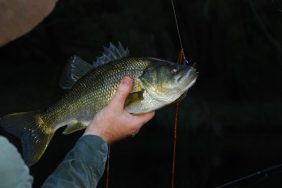Rummage through any seasoned bass angler’s tackle and you’ll undoubtedly stumble across a solid assortment of jigs. Their weighted, skirted design is ideal for punching through weeds and holes in lily pads where you can hop, pull or swim them to draw strikes from hungry bass.
As effective as jigs are, something that makes them even more attractive is their simplicity. Anglers like to tinker and experiment, and over the years many have modified jigs in various ways to maximize their performance on the water.
Here are three things you can do:
Shorten the Skirt
A jig’s profile in the water comes from its skirt and its trailer (usually a soft plastic, like a craw or creature bait). Like topwater frogs, though, you can sometimes get more action by shortening your jig’s skirt. By snipping the skirt to just past the bend of the hook, you create a smaller, more compact profile, which gives your jig more flair, allows it to fall faster in the water and offers a more subtle profile, which can help you get a few extra bites.
Trim the Weed Guard
Most jigs come with a strong weed guard that’s designed to keep the jig from snagging as you retrieve it through weeds and other cover. On some jigs, though, the weed guard is so thick and strong that it hinders your successful hook-ups. By cutting off some of the strands—a quarter to even a half of them—right where they leave the jig’s head, you can dramatically increase your hook-up percentage and still maintain a snag-free retrieve.
Tie Off the Skirt Yourself
Whether you’re throwing jigs, spinnerbaits or buzzbaits, you’ve more than likely made a cast and had the bait come back now and then with the skirt pulled down on the hook. This happens because most tackle companies use a traditional band to secure the skirt, which is not a reliable permanent solution. To keep your jig’s skirt in place, you can tie a length of braided line around it and tie it off, or take a four-inch piece of thin diameter craft wire and wrap it around the skirt, twisting it to tighten it.








